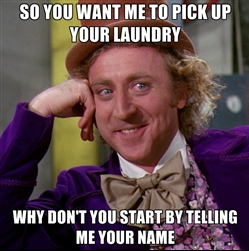 Over the course of my online marketing career, I’ve had the opportunity to participate on both sides of the online PR outreach process, pitching publications on behalf of clients as well as receiving them as a search and social industry journalist. In the course of performing outreach for clients and receiving hundreds of pitches from other PR professionals and in-house marketers, a few important rules became crystal clear.
Over the course of my online marketing career, I’ve had the opportunity to participate on both sides of the online PR outreach process, pitching publications on behalf of clients as well as receiving them as a search and social industry journalist. In the course of performing outreach for clients and receiving hundreds of pitches from other PR professionals and in-house marketers, a few important rules became crystal clear.
Companies use online PR in a number of different ways, depending on the desired outcome. You might pitch mainstream media to offer a company executive up as an expert source on a breaking news story, in order to build your company’s credibility. Where the goal is to earn links back to your website, you may offer guest posts or interviews to industry bloggers or digital magazines. Your focus might be increased exposure in your target market, in order to increase sales of a certain product or service.
Practicing good etiquette in your outreach efforts doesn’t ensure placement in news publications or links from sources that could help your business. However, failing to follow these rules will almost certainly result in your pitch landing in the virtual Trash can.
1. Don’t Ask for Anything in a First Pitch You Wouldn’t Request the First Time Meeting a Stranger
 All but the smallest of industry blogs, magazines, newsletters and other publishers get dozens or even hundreds of PR pitches a week. It’s more important than ever to establish a relationship before that first pitch, in order to go in warm and increase the chances your request will even be read.
All but the smallest of industry blogs, magazines, newsletters and other publishers get dozens or even hundreds of PR pitches a week. It’s more important than ever to establish a relationship before that first pitch, in order to go in warm and increase the chances your request will even be read.
Thankfully, this is also easier than it’s ever been. Journalists, bloggers, thought leaders and other influencers usually have social media accounts you can use to connect in advance of a pitch. This advice can be taken too far; using a churn and burn approach to relationship building quickly becomes obvious. You don’t want to be “That Guy” who is everyone’s buddy for about 5 minutes, before he asks for a product review and disappears, never to be heard from again.
Take the time to build a relationship with the people you’d like to interview with or write for – it just makes sense. Think about it: if they’re so influential in your industry (or in media in general) that you would like them to publish something about your company, why on earth wouldn’t you want to have that person in your social circle, to learn from, converse with and possibly influence yourself?
2. Do the Legwork to Ensure Your Pitch is a Good Match for the Publication
Pitching a publication with an offer to write a guest post about the different ways Product Type XYZ is used in the home is useless if they just published a post about it last week. Bloggers and other online publishers also typically have editorial guidelines and a certain style or voice to which writers must adhere. They’ll share that information with you if your pitch is selected, but you can capture their attention by showing a deep understanding of their publication in their pitch.
Try one of these tactics to stand out in the pitch pile:
- Reference a previously published piece of content and explain how your concept builds on it, ie.: “Your October post on buttercream frosting application techniques was very helpful. My post on tools to use in this process ties nicely into that and will provide a link back to your article.”
- Show your understanding of their audience and style, ie.: “We’ve enjoyed sharing your how-to posts internally; our staff find your direct, step-by-step approach easy to follow. In an interview, you will find I offer the same type of logical process for completing XYZ project in order to give readers everything they need to do it right, start to finish.”
- Recommend an author, columnist or interviewer for your piece, ie.: “I’ve read many of Ashley Zeckman’s articles and felt she might be a great fit to discuss our perspective on the recent changes in the industry.”
The idea is to familiarize yourself with their work, then convey that knowledge in your pitch.
3. Come Armed with a Unique, Original Idea
 Every time Google updates their algorithm, search journalists industry-wide pull their hair out over these pitches:
Every time Google updates their algorithm, search journalists industry-wide pull their hair out over these pitches:
“Hi Miranda, you might have heard the news about Google’s recent algorithm update. So-and-So, CEO of XYZ Company, is available to discuss what this means for marketers in an interview at your convenience. Our company has millions of clients and makes billions of dollars and we’re so awesome I can’t even believe it myself [insert more corporate PR hot air here]; when can I pencil you in?”
What is it, exactly, that you have to offer that the publication can’t find elsewhere? Have you done an original study, or seen a trend across a number of clients that might interest readers? This is what the person you are pitching wants to hear.
A direct pitch is not the place to insert the same promotional blurb you append to your press release. Ideally, you have already established a relationship with the person you are pitching and therefore need to focus on your unique value proposition. Regurgitating your Company Overview is an annoying waste of space that earns you an instant ticket to the Trash can.
The Elements of a Great Online Public Relations Pitch
Once you’ve established and nurtured relationships with the people and publications potentially open to including you as a guest blogger, expert source, featured company/product or otherwise, make sure your pitch has the following elements to stand out amongst the inbox noise:
- A clear, descriptive Subject Line – whether via email, social messaging or otherwise, make use of that first opportunity to catch the reader’s eye and attention.
- An introduction that states your unique value proposition upfront. Ideally, this one or two sentence intro will tell the reader who you are, why you’re a valuable source of information specific to their audience and what you bring to the table for this specific piece of content.
- A clear description of your idea, insight or information offering. In the main body of the pitch, show the reader you have thought this out and ready to go. This isn’t the place to hold your cards close to your chest or be vague.
- Links to a few items that may help the journalist/blogger choose you as a source over another candidate. This might include a popular social media account, an article on another (non-competitive and preferably high caliber) publication in which you were featured or a video of a speaking engagement on a related topic, for example.
- Access to your original research or any other material to which you refer in your pitch. There is nothing more annoying than a company offering a journalist an interview based on a report they have to access via an online signup form. Just send the document; they don’t want to be on your mailing list.
- Any timeline restrictions, if applicable. For example, if you are offering an interview on an embargoed report that will release in two days, let the person you are pitching know of any exclusivity they can have as well as the time constraint.
- The best contact information to arrange an interview, guest post or other publicity opportunity. Amazingly, many companies release news yet are not willing to be interviewed to discuss it. Making someone available for a 15 minute phone call may give the person you are pitching the exclusive content element that influences their decision to take you on.
What has been your biggest challenge in pitching bloggers, journalists or other media? Share your stories and any tips for other readers in the comments!


